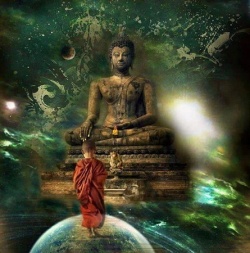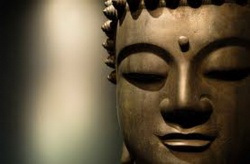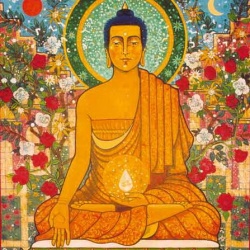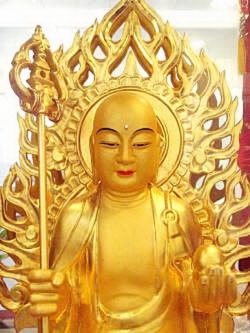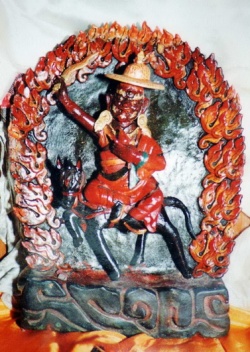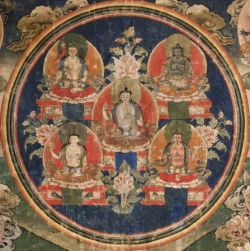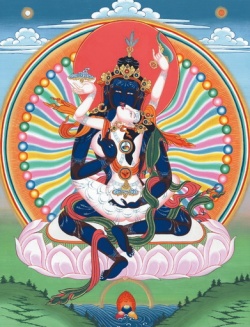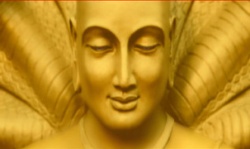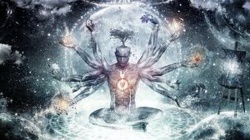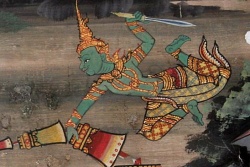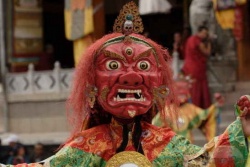Sunyatasaptati Seventy Verses on Sunyata attributed to Nagarjuna
Introduction
This text is in 73 verses (originally composed in the arya meter like the Vigrahavyavartan I and the Pratltyasamutpadahrdayakarika), accompanied by a commentary from the author's own hand (svavrtti). It is ascribed to Nagarjuna by Bhavya/9 Candrakirti,80 and Santaraksita.81 Testimonies anterior to these are found in the Akutobhaya 82 and the *Dvadasadvaraka.83 Later on it is also referred to by Atisa.84 I have seen no references or allusions to the svavrtti, but as us prose style (in Tibetan, to be sure) is quite similar to the style of the commentaries on the VigrahavyavartanI and Vaidalyaprakarana, there is no good reason to impeach its authenticity.85
The doctrine and scope of the Sunyatasaptati do not differ from those of the Mulamadhyamakakarika, to which it may be said to form an appendix,86 as it partly summarizes its verses, partly introduces new topics and elaborates old ones.87 Like the Mulamadhyamakakarika, it reveals no strict underlying structure of composition, but it may, as I have ventured, be divided into at least seven paragraphs.
For the study of the Sunyatasaptati I have had available several texts preserved in Tibetan, all of which are cited in the section on sources and variants in Part I.88 The translations of the karikas included in the commentaries by Candrakirti and Parahita sometimes differ considerably — at times unhappily — from that given in Nagarjuna's svavrtti, and more often agree with the root text as it is found in the Tibetan Canon.89
As editions and translations of all the commentaries are expected, I have confined myself to an edition and translation of the root text. However, my translation of the karikas strictly follows the svavrtti, with only one or two exceptions, and should therfore be read in conjunction with the edition of the svavrtti given in Part II. Though I have consulted the commentaries of other authors, Nagarjuna's own remarks must of course remain the final authority in questions of interpretation.90
I present here the briefest possible summary of the text (based on the analysis given in the introduction to my Danish rendering of the verses with the svavrtti), followed by notes on the specific verses.
Summary
.
1. The dharmas exist only vyavaharavasat (i.e. sarhvrtitah), as yukti shows that paramarthatah everything is anutpanna. (1-6)
2. All entities (bhava) are pratityasamutpanna, or sunya. So nirvana is simply anutpada. (7-26)
3. Various aspects of bhava are shown to be relative. (27-32)
4. Karma is also sunya according to orthodox Buddhism. (33-44)
5. Refutation of the five skandhas, above all rupa. (45-57)
6. Avidya vanishes when it is understood, as shown, that there is really no bhava or the like whatsoever. (58-66)
7. Paramartha is simply sunya ta, anutpada, and so forth. Since this is not generally realized, one must resort to samvrti with sraddha in order to comprehend it oneself.91 (67-73)
.
Sunyatasaptati - Verses
.
[1] Though the Buddhas have spoken of duration, origination, destruction, being, non-being, low, moderate, and excellent by force of worldly convention, [they] have not done [so] in an absolute sense.
[2] Designations are without significance, for self, non-self, and self-non-self do not exist. [For] like nirvana, all expressible things are empty (sunya) of own-being.
[3] Since all things altogether lack substance — either in causes or conditions, [in their] totality, or separately — they are empty.
[4] Being does not arise, since it exists. Non-being does not arise, since it does not exist. Being and non-being [together] do not arise, due to [their] heterogeneity. Consequently they do not endure or vanish.
[5] That which has been born cannot be born, nor can that which is unborn be born. What is being born now, being [partly] born, [partly] unborn, cannot be born either.
[6] A cause has an effect when there is an effect, but when there is no [effect] the (cause) amounts to no cause. It is inconsistent that [the effect] neither exists nor does not exist. It is illogical that [the cause is active] in the three times.
[7] Without one, there are not many. Without many, one is not possible. Whatever arises dependently is indeterminable.
[8] The twelve dependently arising members, which result in suffering, are unborn. They are possible neither in one mind nor in many.
[9] Permanent is not, impermanent is not, not-self is not, self is not, impure is not, pure is not, pleasure is not, and suffering is not. Therefore the perverted views do not exist.
[10] Without these, ignorance based on the four bad views is not possible. Without this (ignorance), the formative forces do not arise. The same [is true] for the [ten] remaining [dependently arising members].
[11] Ignorance does not occur without the formative forces [and] without it the formative forces do not arise. Caused by one another, they are not established by own-being.
[12] How can that which is not established by own-being create others? Conditions established by others cannot create others.
[13] A father is not a son, a son is not a father. Neither exists except in correlation with the other. Nor are they simultaneous. Likewise for the twelve members.
[14] Just as pleasure and pain depending on an object in a dream do not have [a real] object, so neither that which arises dependently nor that which it arises in dependence on exists.
[15] Opponent: If things do not exist by own-being, then low, moderate, and excellent and the manifold world are not established and cannot be established, even through a cause.
[16] Reply: If own-being were established, dependently arising things would not occur. If [they were] unconditioned, how could own-being be lacking? True being also does not vanish.
[17] How can the non-existing have own-being, other-being, or non-being? Consequently, own-being, other-being, and non-being [result from] perverted views.
[18] Opponent: If things were empty, origination and cessation would not occur. That which is empty of own-being: How does it arise and how does it cease?
[19] Reply: Being and non-being are not simultaneous. Without non-being, no being. Being and non-being would always be. There is no being independent of non-being.
[20] Without being there is no non-being. [Being] neither arises from itself nor from [something] else. This being so, this [being] does not exist: So there is no being, and [therefore] no non-being.
[21] If there is being there is permanence; if there is non-being there is necessarily annihilation. When there is being, these two [[[Wikipedia:dogmas|dogmas]]] occur. Therefore [one should] not accept being.
[22] Opponent: These [[[Wikipedia:dogmas|dogmas]]] do not occur due to continuity: Things cease after having caused [an effect]. Reply: As before [see v. 19], this [continuity] is unestablished. It also follows that the continuity would be interrupted.
[23] Opponent: [No!] The Buddha's teaching of the path aims at showing origination and cessation, not sunyata! Reply: To experience the two as mutually exclusive is a mistake.
[24] Opponent: If there is no origination and cessation, then to the cessation of what is nirvana due? Reply: Is not liberation this: that by nature nothing arises and ceases?
[25] If nirvana [resulted] from cessation, [then there would be] destruction. If the contrary, [there would be] permanence. Therefore it is not logical that nirvana is being or non-being.
[26] If a definite cessation did abide, it would be independent of being. It does not exist without being, nor does it exist without non-being.
[27] The marked is established through a mark different from the marked; it is not established by itself. Nor are the [two] established by each other, [since what is] not established cannot establish the not-established.
[28] In this [way], cause, effect, feeling, feeler, and so forth, the seer, the visible, and so forth — whatever may be — all are explained, without exception.
[29] The three times do not exist (substantially) since they are unfixed and are mutually established, since they change [and] are not self-established, [and] since there is no being. They are merely discriminations.
[30] Since the three marks of the conditioned — origination, duration, and cessation — do not exist, there is not the slightest conditioned or unconditioned (phenomenon).
[31] The non-destroyed does not cease, nor does the destroyed. The abiding does not abide, nor does the non-abiding. The born is not born, nor is the unborn.
[32] Composite and non-composite are not many [and] not one; are not being [and] are not non-being; are not being-non-being. All [possibilities] are comprised within these limits.
[33] Opponent: The Bhagavat, the Teacher, has spoken of karma's duration, of karma's nature, and of karma's result, and also of the personal karma of living beings and of the non-destruction of karma.
[34] Reply: Karma is said to lack own-being. (Karma) that is not born is not destroyed. From that again I-making is born. But the belief that creates it is due to discrimination.
[35] If karma had own-being the body created by it would be permanent. So karma would not result in suffering and would therefore be substantial.
[36] Karma is not born from conditions and by no means from non-conditions, for karma-formations are like an illusion, a city of gandharvas, and a mirage.
[37] Karma has klesas as its cause. [Being] klesas, the karma-formations are of impassioned nature (klesatmaka). A body has karma as its cause. So [all] three are empty of own-being.
[38] Without karma, no agent. Without these two, no result. Without these, no enjoyer. Therefore things are void.
[39] When — because the truth is seen — one correctly understands that karma is empty, karma does not arise. When (karma) is no more, what arises from karma arises no more.
[40] Just as when the Lord Tathagata magically projects an apparition and this apparition again projects another apparition-
[41] In that case the Tathagata's apparition is empty (not to mention the apparition [created] by the apparition!). Both of them are but names, merely insignificant discriminations.
[42] Just so, the agent is like the apparition, and karma is like the apparition [created] by the apparition. By nature [they are] without significance: mere discriminations.
[43] If karma possessed own-being, there would be no nirvana nor deeds [of an] agent. If (karma) does not exist, the pleasant or unpleasant result created by karma does not exist.
[44] 'Is' and 'is not' and also 'is-is not' have been stated by the Buddhas for a purpose. It is not easy to understand!
[45] If form is material (bhautika) in itself, it does not arise from the elements (bhuta). It is not derived from itself—It does not exist, doei it? —nor from anything else. Therefore it does hot exist [at all].
[46] The fouf (great elements) are not [found] in one (element), nor is oftt of them [found] in [any of] the four. How can form be established With the four great elements as [its] cause?
[47] Since it is hot conceivid directly, [it seems form does] not exist. But if [you maintain it to be conceived) through a mark, that mark, borh torn causes and conditions, does not exist. And it would fee illogical [if fOrrrt eOUld exlsl] Without fi mark.
[48] If mind could grasp form, it would grasp its own own-being. How could a (mind) that does not exist (since it is born from conditions) really conceive absence of form?
[49] Since one moment of mind cannot within [the very same] moment grasp a form born (as explained), how could it understand a past and a future form?
[50] Since color and shape never exist apart, they cannot be conceived apart. Is form not acknowledged to be one?
[51] The sense of sight is not inside the eye, not inside form, and not in between. [Therefore] an image depending upon form and eye is false.
[52] If the eye does not see itself, how can it see form? Therefore eye and form are without self. The same [is true for the] remaining sense-fields.
[53] Eye is empty of its own self [and] of another's self. Form is also empty. Likewise [for the] remaining sense-fields.
[54] When one (sense-field) occurs simultaneously with contact, the others are empty. Empty does not depend upon nonempty, nor does non-empty depend upon empty.
[55] Having no [[[Wikipedia:independent|independent]]] fixed nature, the three [namely, indriya, visaya, and vijnana) cannot come into contact. Since there is no contact having this nature, feeling does not exist.
[56] Consciousness occurs in dependence on the internal and external sense-fields. Therefore consciousness is empty, like mirages and illusions.
[57] Since consciousness arises in dependence on a discernible object, the discernible does not exist [in itself]. Since [the conscious subject) does not exist without the discernible and consciousness, the conscious subject does not exist [by itself].
[58] [In a relative sense) everything is impermanent, but [in the absolute sense) nothing is permanent or impermanent. [If there] were things, they would be either permanent or impermanent. But how is that [possible]?
[59] Since the entities 'desire', 'hatred', and 'delusion' arise through perverted views about pleasant and unpleasant, desire, hatred, and delusion do not exist by own-being.
[60] Since one [may] desire, hate, and be deluded regarding the very same [thing], [the passions) are created by discrimination. And that discrimination is nothing real.
[61] That which is imagined does not exist. Without an imagined object, how can there be imagination? Since the imagined and the imagination are born from conditions, [they are] sunyata.
[62] Through understanding the truth, ignorance, which arises from the four perverted views, does not exist. When this is no more, the karma-formations do not arise. The remaining [ten members vanish] likewise.
[63] The thing that arises in dependence upon this or that does not arise when that is absent. Being and non-being, composite and non-composite are at peace — this is nirvana.
[64] To imagine that things born through causes and conditions are real the Teacher calls ignorance. From that the twelve members arise.
[65] But when one has understood by seeing fully that things are empty, one is no longer deluded. Ignorance ceases, and the twelve spokes [of the wheel) come to a halt.
[66] Karma-formations are like the city of gandharvas, illusions, mirages, nets of hair, foam, bubbles, phantoms, dreams, and wheels made with a firebrand.
[67] Nothing exists by virtue of own-being, nor is there any non-being here. Being and non-being, born through causes and conditions, are empty.
[68] Since all things are empty of own-being, the incomparable Tathagata teaches dependent co-origination regarding things.
[69] The ultimate meaning consists in that! The perfect Buddhas, the Bhagavats, have [only] conceived the entire multiplicity in reliance upon worldly convention.
[70] The worldly norms (dharmas) are not violated. In reality [the Tathagata) has not taught the Dharma. Not understanding the Tathagata's words, [fools] fear this spotless discourse.
[71] The worldly principle, "This arises depending on that," is not violated. But since what is dependent lacks own-being, how can it exist? That is certain!
[72] One with faith who tries to seek the truth, one who considers this principle logically [and] relies [upon] the Dharma that is lacking all supports leaves behind existence and non-existence [and abides in] peace.
[73] When one understands that "This is a result of that/' the nets of bad views all vanish. Undefiled, one abandons desire, delusion, and hatred and gains nirvana.
.
Notes on the Verses
.
1. In the words of MK XXIV, 8: dve satye samupasritya buddhanam dharmadesana; cf. VV 28; YS 30-33. For vyavahara in general, see May (1959), p. 221, n. 760. Here *lokavyavaharavasat equals the karyavasat of YS 33.
2. This verse about tattva (i.e., paramartha, etc.) summarizes MK XVIII, 1-7.
3. For a similar reason for anutpada, see VV 1, 21; MK I; XX. Due to the fact that things lack svabhava they are termed sunya. VV, passim.
4. This refutes the three hypothetically possible subjects of origination: sat, etc. Really there are four kotis; see e.g. CS III, 23. Similar refutations in MK VII, 20; CS I, 13, and elsewhere.
5. Refutation of utpada as the first of the three samskrtalaksana; cf. MK VII, 1-2. While this verse corresponds to *Dvadasadvaraka 26 (Taisho 1568, 167a23-24), the latter may have read "jatajatavinir-mukta (cf. MK II, 1) in pada c.
6. Again, utpada is absurd because the notion of hetu (i.e. to utpada) is untenable. See MK XX; RA I, 47: pragjatah sahajatas ca hetur ahetuko 'rthatah I prajnapter apratitatvad utpattes caiva tattvatah II
7. Things (bhava) are also empty because they cannot be indicated (animitta) in terms of numbers (samkhya), since numbers also are pratityasamutpanna. Here the concept of eka/aneka seems quite concrete, so that eka = ksana or paramanu. Cf. RA I, 67-71.
8. Nor can citta (sems) be called eka or bhinna (i.e. aneka) because, as we shall see, its 'content' (i.e., duhkha due to avidyadi) is in fact ajata. This verse is 'quoted' at *Dvadasadvaraka 2 (160a22-23).
9. The four viparyasas (see MK XXIII) do not exist in themselves. Hence avidyadi, which is based on them, does not exist either.
11. Again, avidyadi are anutpanna (i.e. sunya) because they are pratityasamutpanna (in the sense of MK XXVI, 1-12 and/or PK 1-5), pitaputravat (cf. VV 49-50). Thus sukha and duhkha (compare v. 8) are no more real than experiences in a dream (cf. CS I, 17; III, 5).
15. In fact, aU the laukikasamvyavahara (see MK XIV, 6-40; VV 70; v. 1 above) are only possible because they are pratityasamutpanna.
17. The various forms of bhava (svabhava, parabhava, abhava and bhava as such) are only conceivable in mutual dependence. They do not occur independently. Compare MK XV. For v. 18. in particular cf. MK XXIV, 1; XXV, 1-2. The Akutobhaya ad MK XXI, 6 quotes 19-21 as being from the Sunya tasaptati. *Dvadasadvaraka 20 (164b27-28) seems to be identical with SS 19.
21. Acceptance of bhava would also imply sasvatocchedagraha. Cf. May, op. cit., p. 213, n. 720; 11] XXIII, p. 179, n. 58 (cf. ibid., p. 178, n. 9); MK XXI, 14. The verse is quoted in Madhyamakalarhkaravrtti, Pek. ed. 5285, Sa, fol. 75a (with Catuhsataka X, 25 and RA I, 60 to the same effect).
22. The notion of samtana does not prevent sasvatocchedagraha. Cf. v. 19; MK XVII; XXI, 15-21. This, of course, is the case only paramarthatah. Cf. MK XXVII, 22; Catuhsataka X, 25.
23. Since there is no bhava, etc., nirvana cannot be defined as (bhava)nirodha, or abhava. In fact, utpada and nirodha are sheer illusions (cf. MK XXI, 11 and Lankavatara X, 37; MK XXV; RA I, 42; SL 105, 123). Thus Nagarjuna's notion of nirvana does not incur sasvatocchedagraha.
27. Again, bhava in its various forms cannot be established by means of laksyalaksana because they are asiddha (see MK II, 21). Cf. MK IV, 7; V; CS I, 12; *Dvadasadvaraka 18-19 (163cl6-17; 164alO-ll).
29. This refutation of kala is a summary of MK XIX. See also *Dvadasadvaraka 25 (166c21-22); Catuhsataka XI.
30. Sarhskrta and asamskrta cannot be established because their three laksanas (utpada, sthiti, bhahga) cannot be established as either eka or aneka, etc. See MK VII and *Dvadasadvaraka IV (162c-163cl3).
33. What follows is a rather lengthy treatment of karma according to Madhyamaka. 33 summarizes MK XVII, 1-10. The remaining verses explain why, paramarthatah, karma is sunya and how it is pratityasamutpanna: Vikalpa (cf. v. 64) in the form of aharhkara (cf. RA I, 27-35) generates klesa (cf. MK XXIII, 1; XVIII 5), which again gives rise to karma, which finally conditions one's deha (MK XVII, 27) or rebirth (janma; see RA I, 35; II, 24). This cyclic process (cf. PK 1-5) can only cease through cognition (jnana, darsana, etc.) of tattva; that is, of sunya ta. SS 40-42 rec. by La Vallee Poussin, Prasannapada, p. 330, n. 1. The Buddha's desana (v. 44) varies, as it depends upon sattvasaya. See MK XVIII, 6; BV 98-99; RA IV, 94-96; YS 33.
41. Is this verse a later interpolation?
44. An allusion to satyadvaya, the two truths.
45. In vv. 45-54 the author refutes the existence of rupa, which, sarhvrtitah, is varna and samsthana (see v. 50). First, rupa is unreal because it is neither one with the mahabhuta nor different from them. Similarly MK IV, 1-5.
46. Again, the mahabhuta cannot be established as eka or aneka (RA I, 83-89). So rupa cannot be bhautika. Cf. RA I, 99; CS I, 5.
47. One cannot infer the existence of rupa from its lihga. This means, I assume, that bhautika cannot e.g. be subtle, as it is derived from bhuta that must be gross. See RA I, 90; Pancaskandhapra-karana, p. 2. If, on the other hand, rupa really did exist (as the Abhi-dharmika contends), it could not be without lihga (i.e. it could not change its linga under the influence of the mahabhuta).
48. Here I take buddhi in the sense of caksurvijhana (cf. the use of ghatabuddhi at VP 16-19). Since caksurupe pratltyaivam ukto vijnanasarhbhavah (RA IV, 55), such a buddhi is med pa; i.e., sunya. So it cannot perceive rupa, to which a similar argument applies. Moreover, buddhi would have to perceive itself (which is absurd) in order to perceive other things (i.e. rupa). Cf. MK III, 2 (which must be understood in the sense of Catuhsataka XIII, 16); RA IV, 64.
49. Again, buddhi cannot perceive rupa/visaya, for being ksanika, objects are never sarhprata. A buddhi which has atlta or anagata as its object is vyartha. See RA IV, 56-57.
50. That ruparh dvidha varnah samsthanarh ca is well-known; cf. e.g. Amrtarasa, p. 115; Pahcaskandhaprakarana, p. 4. See also Catuhsataka XIII, 7.
51. Similarly Catuhsataka XIII, 17.
52. As each of the twelve ayatanas cannot fulfill its respective function in itself it lacks svabhava and is sunya, for akrtrimah svabhavo hi nirapeksah paratra ca (MK XV, 2). Cf. MK III.
54. The commentariu^ to this verse are far from exhaustive. But see RA IV, 52-54. Since each of the six sparsayatana (= indriya, for which see the references in CPD II, p. 129) can have only one object (artha/visaya) at a time (RA IV, 52; Catuhsataka XI, 18), the senses and their respective objects, taken pratyekam, must be vyartha (RAIV, 54).
55. There can be no sarhnipata (i.e., sparsa: MK XXVI, 5) between indriya, visaya, and vijriana, since as shown (see also MK XIV) none of the three exist by themselves. Hence they cannot come together. Thus it is only sarhvrtitah that one can say sparsac ca vedana sarhpravartate (MKXXVI, 5).
56. A refutation of the fifth skandha, its objects, and its agent. Similarly CS I, 10; BV 26-56; Catuhsataka XIII, 23. Cf. CS III, 50.
58. Verses 58-61 argue that the four perverted views, the source of avidya (see vv. 10, 62), do not exist paramarthatah. Since the concept of bhava is untenable (as shown in vv. 7, 17 ff.), nothing can really be either nitya or anitya, etc. The verse is quoted in Madhyamakalamkaravrtti, loc. cit., 72b: thams cad rtag min mi rtag pa'ang I I ci yang med de rtag de bzhin I I dngos yod rtag dang mi rtag par I I 'gyur na de ni ga la yod II.
59. The klesas are — sarhvrtitah — born from the perverted views (MK XXIII, 1). But as experience shows (cf. BV 19-20; Catuhsataka VIII, 2-3), the perverted views must be sheer vikalpas. This implies that a vikalpa really has no definite object before it. Thus, paramarthatah, without an object a vikalpa is simply nothing.
62. Now that avidya has been deprived of its basis, the eleven aiigas based upon avidya also vanish, QED. Cf. the identification of avidya with pindasamjria, etc. (= viparyasa) in the Salistambasutra, quoted in the Prasannapada, p. 562.
63. So avidya is simply lack of awareness of the universal law of pratltyasamutpada. See MK XVIII, 9-11. It is, as the svavrtti to v. 64 says, brten pa'i dngos por mngon par zhen pa dang Ita ba dang rtog pa dang 'dzin pa. We may add bhavabhavaparamarsa, RA I, 42; bhavabhyupagama, YS 46. See the Dhammasahgani, p. 213 for these equivalents (. . . gaha, patiggaha, abhinivesa, paramasa, vipariyasaggaha . . .)
65. When one realizes that bhava, etc. are sunya; that they lack svabhava and are like illusions, etc., avidya and the rest vanish. This amounts to paramartha. Cf. MK XXVI, 11; CS III, 36 ff.
69. However, as long as one has not yet realized paramartha, one must have sraddha (cf. RA I 5-6) and rely on vyavahara (cf MK XXIV, 8-10; BV 67). In this way is nirvana; i.e. ragadvesa-mohaprahana (°ksaya) (see SS 221a4, quoting Sarhyuktagama; cf. Samyutta IV, p. 251 ff.), approached and attained (cf. MK XXIV, 10).
.
.
